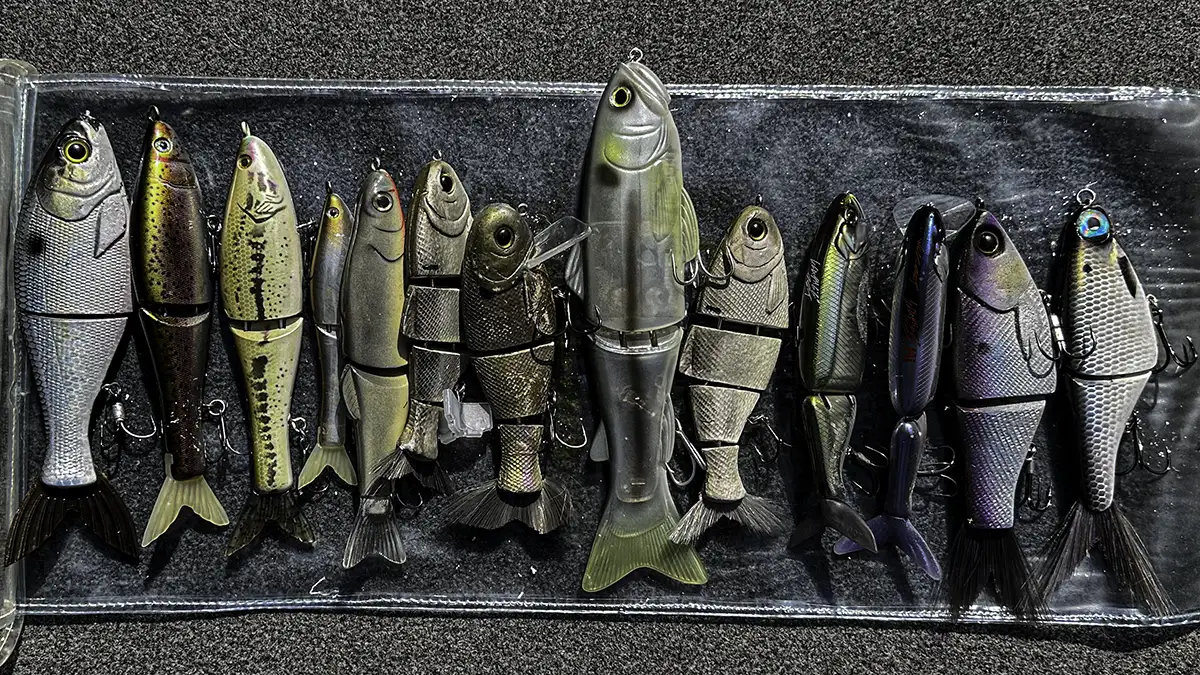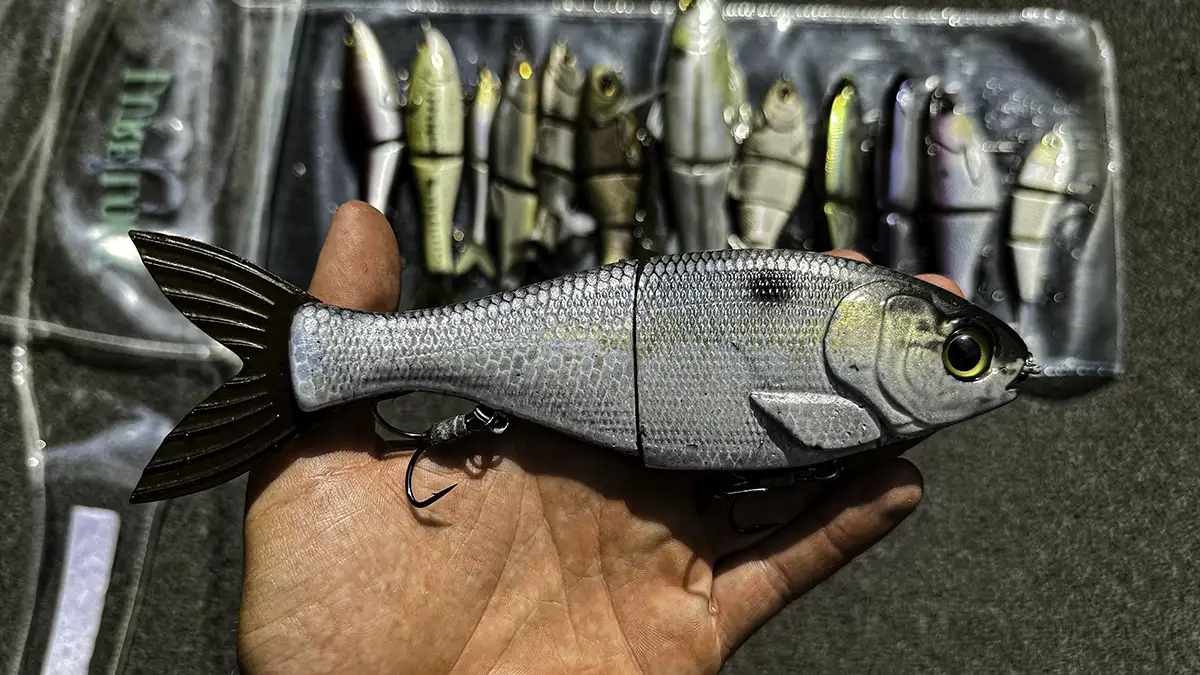Summertime can be one of the most diverse and fun times of the year to go fishing. With bass both shallow and out deep, there are tons of different ways to catch them. However, one of my favorite ways to catch fish this time of year is throwing a glide bait.
Once the bass finish up spawning, they start looking for big easy meals to help them replenish after the spawn. Throwing a big glide bait is a great way to capitalize on these big post spawn bass looking for an easy meal. This technique can lead to some really big bites as well as your most memorable days on the water.
There are a couple different ways to fish a glide bait depending on the conditions and body of water you’re on. Understanding when and where to throw these baits are key to having a successful day. Here are a few the key tips to help you make the most of your time on the water throwing a glide bait.
MANAGE YOUR EXPECTATIONS
The first key to having a fun day throwing a glide bait is managing your expectations. When you’re throwing a bait like this, you’re often fishing for some of the biggest fish in the lake. Depending on the body of water you’re on, there may only be a select number of fish big enough to commit to a big glide bait. This means you may only be fishing for one or two bites a day, so its important to not get discouraged if you don’t get a bite for the first couple hours.
This being said, it is not just big fish that eat these giant baits. I’ve had numerous days where I’ve caught tons of one to three pounders throwing a glide bait. One of the best types of fisheries for getting tons of bites on a glide bait are spotted bass fisheries.
WHEN TO THROW A GLIDE
Clear water spotted bass fisheries can be some of the most productive bodies of water for getting tons of action on a glide bait. These lakes typically have tons of fish, and really clear water. This gives you the ability to draw fish in from a long ways away, giving you more opportunity for a strike as opposed to dirty water where your baits are less visible. This mix of clear water and lots of competition from other fish often leads to tons of aggressive strikes.
These types of fisheries are where I often get the most bites throwing a glide bait. The shear number of fish in these lakes, paired with enhanced visibility is your best bet for going out and getting a ton of bites throwing a glide. This is also a great way to catch some of the biggest fish in these types of reservoirs. Big clearwater largemouth are often very weary and hard to trick, but throwing a glide bait is one of the best ways to get these fish to react. Especially after they finish up spawning and are looking for an easy meal.
One of the best days I’ve ever had throwing a glide bait occurred on a local spotted bass fishery here in Auburn, Alabama. I was fishing docks in spawning pockets as well as shoals the spotted bass typically use to spawn on. I caught numerous largemouth over 4 pounds throwing a glide bait on the edge of docks. I would give this bait a slow retrieve along the side of the dock allowing them to shoot out from under the dock and slam it, often close enough for me to see the strike.
I then transitioned to shoals later in the day and caught numerous spotted bass over 3 pounds. The fish were using these shoals as an ambush point to feed up on baitfish after they finished up spawning. I would throw my glide bait up towards the shallowest part of the shoal, and slowly fish it back towards me. Once the glide bait reached the drop off, the fish would shoot up and ambush it once it got into the open water.
TYPES OF WATER GOOD FOR GLIDES
While spotted bass fisheries are a great place to throw a glide bait, I also love to throw them on lakes that are known for having tons of big largemouth. Places such as lake Guntersville and Lake Eufaula are widely known for having a large population of big largemouth. Throwing a glide bait on these types of fisheries are a great way to capitalize on the big fish living in these bodies of water.
The reason these bodies of water are so great for throwing a glide bait is because of the large number of giant bass that reside in them. This means you will have far greater likelihood of putting your bait in front of a trophy bass willing to commit to such a big bait. While you often don’t get as many bites on these bodies of water as opposed to spotted bass fisheries, you often get much bigger bites.
These lakes typically have dirtier water as compared to clear spotted bass reservoirs. This means you will get far less followers on these types of lakes, however the ones that do see it are far more likely to commit given their lack of visibility.
Both types of bodies of water can lead to some really fun days on the water. These two types of lakes are where I typically throw a glide bait. This is due to either a prevalent amount of big largemouth, or having clear water with lots of fish. While both types can produce some fun days of fishing, there are a couple different ways to approach these differing bodies of water.
TECHNIQUES FOR GLIDE BAITS
Throughout the early parts of the summer, there are fish both shallow and deep. So it is important to explore both depths when searching for a glide bait bite. One of my favorite ways to fish a glide bait this time of year is up shallow looking for big post spawn fish.
When fishing shallow with a glide bait, there are a few key things to look for. One of my favorite pieces of cover to fish with a glide bait is a dock. Docks hold tons of baitfish such as bluegill and shad year round. Big bass love to fit under these docks and wait for an opportunity to eat one of these larger baitfish using the dock as cover. A glide bait perfectly imitates these baitfish and is a great way to trick these weary bass into committing.
Another piece of cover that I like to look for this time of year is overhangs. I like to look for trees and bushes that stick out over the water providing a shade line. This time of year, bluegill love to tuck under the overhangs in order to feed on the insects that fall down into the water. This also attracts big bass to come feed on the bluegill using these shade pockets. Paralleling these shade lines with a glide bait is a great place to start this time of year when your looking for a big bite.
Another place that is important to look this time of year is out on brush piles and ledges. Depending on the depth, I will put suspend strips or lead wire on my glide bait in order for me to sink it down to these deeper fish. When fishing a brush pile, it is important to make a long cast and slowly work the bait back over the top of the brush pile. This will often call fish out of the brush to come take a closer look or commit to your bait. I also like to make several casts over the brush pile and change my cadence in order to trigger the more weary fish into biting.
The next place I like to target is ledges with schools. I will start off by using side scan to locate a school. I then like to sink my glide bait to just a few feet over their heads and make a slow retrieve back. The competition of having multiple fish following your bait typically causes one to commit and eat it. This is a great way to catch multiple giant fish in a short amount of time on a big glide bait. There are tons of ways to fish a glide bait year round, however this is a great place to start when looking for a glide bait bite during the early summer.
GLIDE BAIT SETUPS
Throwing a glide bait is a great way to get some really quality bites throughout the day, however you usually don’t get many. This is why it is super important to have the right setup in order to land those key fish.
When throwing these giant baits, it is important to have a rod that can handle the weight of the bait while still having a soft enough tip to keep from puling the bait out of the fishes mouth. I typically like a longer rod with a really strong backbone. This gives you the power to cast such a big bait as well as gives you added leverage over the fish when your fighting it to the boat.
Along with a strong backbone, it is also important to have a softer rod tip. This keeps you from pulling the bait out of the fishes. Often when throwing a glide bait the fish tend to nip at the back end of the bait only grazing the back treble hook. This soft rod tip allows you to get a better hookup ratio with these fish and keep from ripping the hook up of the fishes mouth. My go-to rod for throwing a glide bait is a Dobyn’s Champion XP Swimbait Rod 8-foot heavy.
For a reel you want one with a big enough spool to handle the large caliber line you often throw with these giant baits. I also prefer a larger sized reel paired with big handles giving you a strong grip on the reel in order to winch fish to the boat once you hook them. It is also important to have a a reel with a lower gear ratio. This allows to you work the bait at a slower pace while also giving you enough torque to reel in these larger sized fish. My go-to reel for throwing a big glide bait is the Shimano Curado 300K in the 4:7:1 gear ratio.
Throwing a big bait all day can seem like a daunting task, but it can quickly lead to some unforgettable catches and days on the water. Having success on these baits is all about having the confidence to throw it. These tips should help you gain more confidence and see greater success throwing a glide bait on your favorite bodies of water this summer.














